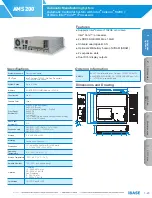
15
Erhöhen Sie die Drehzahl stufenweise und
stellen Sie sicher, dass das Öl minimum eine
Temperatur von 35° C hat, bevor mit maximaler
Drehzahl gefahren wird.
Wichtig:
Lassen Sie den Hydraulikzylinder niemals ohne
Hydraulikdruck rotieren. Dies würde schwer-
wiegende Beschädigungen der Lager und der
Drehzuführung zur Folge haben.
Niemals den Spannzylinder mit hoher Drehzahl
bei kaltem Öl rotieren lassen! Dies führt zu
Beschädigungen der Lager und der Ölzufüh-
rung. Wir empfehIen, einige Betätigungen
(Spannen
und
Entspannen)
bei
niedriger
Drehzahl
durchzuführen,
bevor
mit
dem
Produktionszyklus gestartet wird.
9.
Risiken und
Sicherheitsmaßnahmen
9.1
Direkte Risiken
Die OPUS-V Zylinder bestehen aus 2 Haupttei-
len. Einer davon ist stationär, der andere rotiert
mit hoher Drehzahl. Bei Nichtbeachtung der Be-
triebs- und Wartungsanleitung besteht immer
die Möglichkeit, dass die beiden Teile zueinan-
der in Kontakt kommen und sich festsetzen.
Installation
Lesen Sie die Kapitel 6, 7 und 8 dieser Betriebsanleitung
aufmerksam durch (bitte beachten Sie speziell das Kapitel 8).
Lesen Sie im Kapitel »10. Problemanalyse« die Punkte 1 – 7
sorgfältig durch.
ACHTUNG:
Wenn der Zylinder zum ersten Mal in Betrieb
genommen wird und rotiert, stellen Sie sicher,
dass sich keine Personen in der Nähe des
Zylinders aufhalten.
Anwendung und Wartung
Um das Festsetzen des Zylinders während der Rotation zu
verhindern, beachten Sie die Kapitel 6, 7 und 8 dieser
Betriebsanleitung sehr sorgfäItig.
9.2
Indirekte Risiken
Unter indirekten Risiken versteht man Risiken für den
OPUS-V Zylinder, die durch unsachgemäßes Arbeiten mit
Kraftspannfuttern oder Spannzangenfuttern entstehen können.
Eine Rotation der Maschinenspindel darf nur
unter Erfüllung folgender Voraussetzungen
erfolgen:
Das Erreichen des korrekten Systemdrucks muss über
einen Druckwächter kontrolliert werden.
Die berührungslosen Endschalter der Wegekontrolle (2
Stück oder mehr), müssen die Bestätigung »Werkstück
gespannt« anzeigen und bestätigen.
Gradually increase the rotation speed and
check that the feeding oil has a minimum
temperature of 35° C before attaining the max
speed.
Important
Never allow the cylinder to rotate without oil
pressure. This will damage the bearings, cause
seizure of the distribution ring and the body.
Never rotate the cylinder at high speed with
cold oil; this could damage the bearings and
the manifold ring. We recommend making a few
movements (opening / closing) at a low speed
before starting.
9.
Analysis of the risks and safety
standards
9.1
Direct risks
The OPUS-V cylinder consists of two parts: one
is fixed and one rotates at high speed. As a
conse quence, there is the possibility of a
seizure between the two parts in case of non-
compliance with the correct installation and
maintenance instructions.
Installation
Carefully read and follow the instructions of chapter 6, 7 and 8
of this manual. Special care must be given to chapter 8.
Carefully read in chapter “10. Trouble shooting” the points
1 – 7.
CAUTION:
When the cylinder is rotated for the first time,
be careful that all personnel stand well clear of
the cylinder.
Use and Maintenance
To avoid a seizure during the operation, carefully follow the
instructions of chapter 6, 7 and 8 in this manual.
9.2
Indirect risks
Indirect risks are those that can derive from improper working
or
driving
of
the
OPUS-V
cylinder,
when
clamping
components with power chucks or collets.
The machine must be allowed
to rotate only under the following
conditions:
After having checked with a pressure gauge that the
feeding circuit has reached the requested pressure.
After the proximity switches (2 pcs. or more), or other
systems have confirmed the position of “component
clamped”.













































